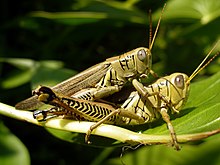Differential grasshopper
| Differential grasshopper | |
|---|---|

| |
| Differential grasshoppers copulating | |
| Scientific classification | |
| Domain: | Eukaryota |
| Kingdom: | Animalia |
| Phylum: | Arthropoda |
| Class: | Insecta |
| Order: | Orthoptera |
| Suborder: | Caelifera |
| Family: | Acrididae |
| Genus: | Melanoplus |
| Species: | M. differentialis
|
| Binomial name | |
| Melanoplus differentialis (Thomas, 1865)[1]
| |
| Subspecies | |
| |
The differential grasshopper (Melanoplus differentialis) is a species of grasshopper belonging to the genus Melanoplus. It is found throughout northern Mexico, the central United States[2] and southern Ontario, Canada.[3] It is considered a pest over most of its range.[2]
Description
Adult males grow to 28–37 mm, and females grow to 34–50 mm. They are brownish or greenish, and as they age the color will darken. Some nymphs can be bright yellow. There are black grooves on the pronotum. The male has bootlike appendages at the end of its abdominal tip.[4] There are inverted chevrons along the hind femur, and the hind part of the tibia is yellowish with black spikes. All adults have yellow tarsi and antennae, or in some cases reddish-yellow antennae.[5]
-
Gravid female Naperville, USA
-
Ovipositing in soil Naperville, USA
Range and habitat
The differential grasshopper is found throughout most of the United States, except for the northwest.[6] Within its range, it is most often found in heavily weeded areas and grasslands, and even in vacant lots and other urban areas.[7] This species is not migratory, but can travel a few miles to search for food. In the northern part of its range, M. differentialis is about as numerous as the two-striped grasshopper (Melanoplus bivittatus), but in the southern part of its range greatly outnumbers it.[8]

Life cycle

There is one generation per year. An adult female lays up to six egg masses in soft soil, each of which can contain 40–200 eggs. The eggs begin embryonic development the summer they are laid, then enter diapause for the winter, to hatch over a period of about two weeks in early summer of the next year. After hatching, nymphs take about 32 days to reach adulthood. Their development is well synchronized, and most nymphs transform to winged adults during a period of just a few days.[9] Differential grasshoppers are polyphagous, eating both grasses and forbs, but experiments have shown that they grow faster if fed forbs. The most favored food plants tend to be giant ragweed (Ambrosia trifida), common sunflower (Helianthus annuus), and prickly lettuce (Lactuca serriola). Adults can detect a chemical change in wilted lettuce and sunflowers, and will tend to avoid such plants.
Agricultural problems

The young grasshoppers feed on various grains, alfalfa and hay crops, while adults attack corn, cotton and deciduous fruit crops. A single swarm can destroy a crop in a few days. Because this species tends to feed in large swarms, it can be a serious threat to farming over most of its range.
In smaller numbers, or in urban regions, differential grasshoppers frequently feed on garden vegetables, such as tomatoes, peas, Cannabis, various kinds of squash, and the leaves of those plants.
References
- ^ "ITIS Standard Report Page: Melanoplus differentialis". Retrieved 2009-02-04.
- ^ a b "Grasshoppers". Archived from the original on 2010-12-25. Retrieved 2010-01-18.
- ^ Orthoptera, Ojibway Nature Centre
- ^ Evans, Arthur V. (2007). "Grasshopper, Crickets, and Katydids: Order Orthoptera". Field Guide to Insects and Spiders of North America. Sterling Publishing Co., Inc. p. 94. ISBN 978-1-4027-4153-1.
- ^ Knopf, Milne & Milne (1986). "Grasshopper and Crickets". National Audubon Society Field Guide to North America Insects & Spiders. Alfred A. Knopf , Inc. p. 421. ISBN 0-394-50763-0.
- ^ "Species Melanoplus differentialis - Differential Grasshopper - BugGuide.Net". Retrieved 2009-02-04.
- ^ Kaufman, Kenn; Eaton, Eric R. (2007). "Grasshoppers". Kaufman Field Guide to Insects of North America. Houghton Mifflin Books. pp. 74–75. ISBN 978-0-618-15310-7.
- ^ "Melanoplus differentialis fact sheet". Retrieved 2009-02-04.
- ^ "Melanoplus differentialis fact sheet". Grasshoppers: Their Biology, Identification, and Management. USDA. Retrieved 7 July 2015.
External links
- Melanoplus differentialis[permanent dead link], Univ. of Wyoming
- Melanoplus differentialis, Discover Life
- Orthoptera (grasshoppers, katydids, crickets) of Ojibway, Ojibway Nature Centre
- Articles with short description
- Short description is different from Wikidata
- Articles with 'species' microformats
- Commons link is on Wikidata
- All articles with dead external links
- Articles with dead external links from July 2019
- Articles with permanently dead external links
- Articles with J9U identifiers
- Articles with LCCN identifiers
- Orthoptera of North America
- Insects of the United States
- Melanoplinae
- Agricultural pest insects
- Insects described in 1865

